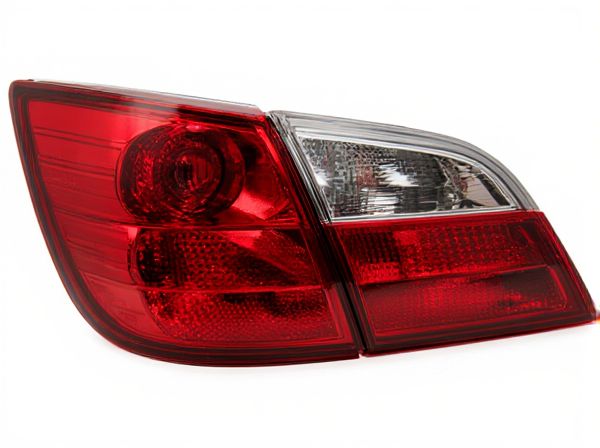
Photo illustration: Aftermarket vs Factory-Fitted Taillight
Choosing between aftermarket and factory-fitted taillights affects your vehicle's safety and style. Factory-fitted taillights guarantee compatibility, quality assurance, and compliance with safety standards while aftermarket options offer diverse designs and potentially lower costs. Your decision should balance aesthetic preferences with reliability and legal requirements to ensure optimal performance.
Table of Comparison
| Feature | Aftermarket Taillight | Factory-Fitted Taillight |
|---|---|---|
| Cost | Lower price, budget-friendly | Higher price, premium quality |
| Quality | Varies; may lack OEM standards | Consistent OEM quality & durability |
| Fitment | May require modifications | Perfect fit, designed for specific model |
| Warranty | Limited or no warranty | Comprehensive manufacturer warranty |
| Design | Various styles, customizable options | Standard design matching vehicle |
| Performance | Variable brightness and longevity | Optimized brightness and lifespan |
| Certification | May lack regulatory approval | Meets safety & regulatory standards |
Introduction to Taillight Options
Taillight options for vehicles primarily consist of aftermarket and factory-fitted units, each offering distinct benefits and considerations. Factory-fitted taillights ensure perfect compatibility and adherence to original equipment manufacturer (OEM) standards, maintaining vehicle safety and warranty. Aftermarket taillights provide a wider range of styles, prices, and customization possibilities, catering to drivers seeking unique looks or enhanced features.
Defining Aftermarket vs. Factory-Fitted Taillights
Aftermarket taillights are replacement or upgrade parts manufactured by third-party companies, designed to fit a wide range of vehicle models and often offering customization options or enhanced features. Factory-fitted taillights are original equipment manufacturer (OEM) components installed during vehicle production, ensuring exact specifications, compatibility, and adherence to safety standards set by the automaker. Choosing between aftermarket and factory-fitted taillights depends on factors such as cost, quality, warranty, and the desired appearance or functionality of the vehicle's lighting system.
Differences in Design and Appearance
Aftermarket taillights often feature customizable designs with LED technology and unique patterns that enhance vehicle aesthetics, while factory-fitted taillights prioritize OEM specifications for consistent style and regulatory compliance. The design of factory-fitted taillights usually matches the vehicle's original look, maintaining uniformity, whereas aftermarket options provide a broader range of styles, finishes, and colors to personalize appearance. Differences in lens materials and housing quality also affect durability and light output, where factory units tend to use standardized components ensuring reliability.
Cost Comparison: Aftermarket vs. Factory-Fitted
Aftermarket taillights typically cost 30-50% less than factory-fitted options, making them a budget-friendly choice for vehicle repairs or upgrades. Factory-fitted taillights, manufactured to original equipment specifications, often come with a higher price due to guaranteed compatibility, warranty coverage, and quality control. Despite the lower initial cost, aftermarket models may vary in quality and durability, potentially leading to additional expenses in the long term.
Installation Process Explained
Factory-fitted taillights are designed for seamless installation with precise fitment and integrated wiring harnesses, ensuring compatibility and minimal adjustment during assembly. Aftermarket taillights typically require additional modifications such as wiring adaptation, bracket adjustments, and alignment efforts, which can increase installation time and complexity. Choosing factory-fitted options guarantees straightforward installation with OEM specifications, while aftermarket alternatives offer customization flexibility at the cost of a more involved setup process.
Compatibility and Fitment Issues
Aftermarket taillights often present compatibility challenges as they may not align perfectly with the exact specifications of factory-fitted units, potentially causing improper fitment and electrical mismatches. Factory-fitted taillights guarantee seamless integration with the vehicle's original wiring harness and mounting points, reducing installation time and avoiding potential safety hazards. Choosing the correct taillight involves verifying model-specific compatibility and ensuring adherence to OEM standards for a secure and functional fit.
Durability and Quality Assessment
Factory-fitted taillights often provide superior durability due to stringent OEM quality standards and precise manufacturing processes, ensuring optimal fit and long-term performance. Aftermarket taillights vary widely in quality, with some offering comparable materials and technology, but others may use lower-grade components prone to faster wear and reduced resistance to environmental factors. Quality assessment of aftermarket options requires thorough examination of material certifications, impact resistance ratings, and compatibility with vehicle electrical systems to ensure safety and longevity.
Impact on Vehicle Warranty
Factory-fitted taillights are usually covered under the vehicle's original warranty, ensuring repairs or replacements are handled without extra cost. Aftermarket taillights, especially those not certified by the manufacturer, can void specific warranty clauses related to electrical or lighting systems. It's essential to consult the vehicle's warranty terms before installing aftermarket lighting to avoid unexpected coverage denials.
Safety Standards and Legal Compliance
Aftermarket taillights often vary in quality and may not always meet stringent safety standards set by regulatory bodies like the Department of Transportation (DOT) or the Economic Commission for Europe (ECE), which factory-fitted taillights consistently comply with. Factory-fitted taillights undergo rigorous testing to ensure optimal visibility, durability, and performance, ensuring full legal compliance and enhanced road safety. Choosing factory-fitted taillights helps prevent potential legal issues and guarantees adherence to mandatory safety regulations for vehicle lighting systems.
Making the Right Choice for Your Vehicle
Choosing between aftermarket and factory-fitted taillights depends on factors such as budget, quality, and compatibility with your vehicle's make and model. Factory-fitted taillights offer guaranteed fitment, compliance with OEM standards, and reliable durability, ensuring optimal safety and performance. Aftermarket taillights provide cost-effective alternatives with diverse styling options but require careful selection to avoid issues with installation and long-term reliability.
 caratoz.com
caratoz.com